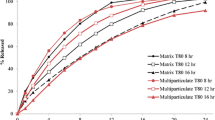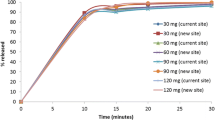Abstract
Formulation changes are common during drug development either due to clinical or manufacturing considerations. These changes especially at later stages of drug development oftentimes raise questions on the potential impact of a new formulation on bioavailability. In this work, the preclinical assessment of formulation bridging risk for a Biopharmaceutics Classification System II development compound is presented. Early clinical studies were conducted using a liquid-filled capsule (LFC). To assess the feasibility of a conventional solid dosage form, an initial analysis was conducted using absorption modeling which indicated conventional formulation of micronized active pharmaceutical ingredient (API) could be a viable option. Subsequently, test formulations were prepared and tested in vivo in dogs. The solid formulations were able to match exposures of the LFC capsule in the dog model; in addition, a sensitivity to API PSD was observed in line with the modeling predictions. When tested in the clinic, the conventional solid formulation resulted in exposures of approximately 25% lower compared to the LFC on an equivalent dose basis; however, bridging with a small dose adjustment would be feasible. The outcome of the clinical study was better predicted by the modeling approach while the dog model appeared to somewhat overestimate absorption. Through the use of preclinical tools and modeling and simulation, a risk assessment around formulation bridging can be conducted and inform formulation decisions or subsequent clinical study designs.




Similar content being viewed by others
REFERENCES
Hariharan M, Ganorkar LD, Amidon GE, et al. Reducing the time to develop and manufacture formulations for first oral dose in humans. Pharm Technol. 2003;2003:68–84.
Amidon GL, Lennernäs H, Shah VP, Crison JR. A theoretical basis for a biopharmaceutics drug classification: the correlation of in vitro drug product dissolution and in vivo bioavailability. Pharm Res. 1995;12:413–20.
Ku MS. An oral formulation decision tree based on biopharmaceutical classification system for first-in-human clinical trials. Bull Tech Gattefosse. 2006;98:89–102.
Li P, Zhao L. Developing early formulations: practice and perspective. Int J Pharm. 2007;341:1–19.
Butler JM, Dressman JB. The developability classification system: application of biopharmaceutics concepts to formulation development. J Pharm Sci. 2010;99:4940–54.
Branchu S, Rogueda PG, Plumb AP, et al. A decision-support tool for the formulation of orally active, poorly soluble compounds. Eur J Pharm Sci. 2007;32:128–39.
Kesisoglou F, Wu Y. Understanding the effect of API properties on bioavailability through absorption modeling. AAPS J. 2008;10:516–25.
Parrott N, Lukacova V, Fraczkiewicz G, Bolger MB. Predicting pharmacokinetics of drugs using physiologically based modeling—application to food effects. AAPS J. 2009;11:45–53.
Heimbach T, Xia B, Lin TH, He H. Case studies for practical food effect assessments across BCS/BDDCS class compounds using in silico, in vitro, and preclinical in vivo data. AAPS J. 2013;15:143–58.
Lukacova V, Woltosz WS, Bolger MB. Prediction of modified release pharmacokinetics and pharmacodynamics from in vitro, immediate release, and intravenous data. AAPS J. 2009;11:323–34.
Zhang X, Lionberger RA, Davit BM, Yu LX. Utility of physiologically based absorption modeling in implementing quality by design in drug development. AAPS J. 2011;13:59–71.
Fleisher D, Sheth N, Griffin H, McFadden M, Aspacher G. Nutirent influences on rat intestinal phenytoin uptake. Pharm Res. 1989;6:332–7.
Agoram B, Woltosz WS, Bolger MB. Predicting the impact of physiological and biochemical processes on oral drug bioavailability. Adv Drug Deliv Rev. 2001;50 Suppl 1:S41–67.
Shono Y, Jantratid E, Kesisoglou F, Reppas C, Dressman JB. Forecasting in vivo oral absorption and food effect of micronized and nanosized aprepitant formulations in humans. Eur J Pharm Biopharm. 2010;76:95–104.
Sugano K. Possible reduction of effective thickness of intestinal unstirred water layer by particle drifting effect. Int J Pharm. 2010;387:103–9.
Rose JP. Effective absorption modeling in relative bioavailability study risk assessment. AAPS J. 2012;14:895–903.
ACKNOWLEDGMENTS
The author would like to thank Kimberly Manser and Linda Rakes for their participation in the conduct of animal studies and subsequent bioanalysis and Henry Wu for his consultation during formulation development.
Author information
Authors and Affiliations
Corresponding author
Additional information
Guest Editors: Divyakant Desai, John Crison, and Peter Timmins
Rights and permissions
About this article
Cite this article
Kesisoglou, F. Use of Preclinical Dog Studies and Absorption Modeling to Facilitate Late Stage Formulation Bridging for a BCS II Drug Candidate. AAPS PharmSciTech 15, 20–28 (2014). https://doi.org/10.1208/s12249-013-0030-6
Received:
Accepted:
Published:
Issue Date:
DOI: https://doi.org/10.1208/s12249-013-0030-6




